Simulation-Based Solutions Reducing Soil and Groundwater Contamination from Fertilizers in Arid and Semi-Arid Regions: Case Study the Eastern Nile Delta, Egypt
Abstract
:1. Introduction
2. Geologic Setting
3. Materials and Methods
3.1. Bahr El-Bagar Drain System
3.2. Geotechnical Data
3.3. Numerical Model
3.4. Model Boundary Conditions, Recharge, Abstraction, and Hydraulic Parameters
4. Results and Discussion
4.1. Geotechnical Investigation
4.1.1. The Hydraulic Conductivity and Porosity
4.1.2. The Mechanical Properties
4.1.3. Chemical Analysis for Soil-Water Extracts
4.2. Hydrological Investigation
4.3. Future Scenarios of Groundwater Fertilizer Contamination
5. Conclusions
Author Contributions
Funding
Acknowledgments
Conflicts of Interest
References
- Morsy, W.S. Environmental Management to Groundwater Resources for Nile Delta Region. Ph.D. Thesis, Faculty of Engineering, Cairo University, Cairo, Egypt, 2009. [Google Scholar]
- Baba, A.; Tayfur, G. Groundwater contamination and its effect on health in Turkey. Environ. Monit. Assess. 2011, 183, 77–94. [Google Scholar] [CrossRef] [PubMed] [Green Version]
- Abd-Elhamid, H.F.; Abd-Elaty, I.; Hussain, M.S. Mitigation of seawater intrusion in coastal aquifers using coastal earth fill considering future sea level rise. Environ. Sci. Pollut. Res. 2020, 27, 23234–23245. [Google Scholar] [CrossRef]
- Abd-Elaty, I.; Abd-Elhamid, H.F.; Qahman, K. Coastal Aquifer Protection from Saltwater Intrusion Using Abstraction of Brackish Water and Recharge of Treated Wastewater: Case Study of the Gaza Aquifer. J. Hydrol. Eng. 2020, 25, 05020012. [Google Scholar] [CrossRef]
- Reddy, A.G.S.; Kumar, K.N.; Rao, D.S.; Rao, S.S. Assessment of nitrate contamination due to groundwater pollution in north eastern part of Anantapur District, A.P. India. Environ. Monit. Assess. 2009, 148, 463–476. [Google Scholar] [CrossRef] [PubMed]
- Rouabhia, A.; Baali, F.; Fehdi, C. Impact of agricultural activity and lithology on groundwater quality in the Merdja area, Tebessa, Algeria. Arab. J. Geosci. 2010, 3, 307–318. [Google Scholar] [CrossRef]
- Abd-Elaty, I.; Zeleňáková, M.; Straface, S.; Vranayova, Z.; Abu-Hashim, M. Integrated Modelling for Groundwater Contamination from Polluted Streams Using New Protection Process Techniques. Water 2019, 11, 2321. [Google Scholar] [CrossRef] [Green Version]
- El Shinawi, A. Instability improvement of the subgrade soils by lime addition at Borg El-Arab, Alexandria, Egypt. J. Afr. Earth Sci. 2017, 130, 195–201. [Google Scholar] [CrossRef]
- Singh, J.; Saggar, S.; Bolan, N.S. Influence of dicyandiamide on N transformation and losses in pasture soil cores. Anim. Prod. Sci. 2009, 49, 253–261. [Google Scholar] [CrossRef]
- Li, J.-S.; Xue, Q.; Wang, P.; Liu, L. Influence of leachate pollution on mechanical properties of compacted clay: A case study on behaviors and mechanisms. Eng. Geol. 2013, 167, 128–133. [Google Scholar] [CrossRef]
- Khodary, S.M.; Negm, N.A.; Tawfik, A. Geotechnical properties of the soils contaminated with oils, landfill leachate, and fertilizers. Arab. J. Geosci. 2018, 11, 13. [Google Scholar] [CrossRef]
- Cyrus, S.; Kumar, T.G.; Abraham, B.M.; Sridharan, A.; Jose, B.T. Effect of industrial wastes on the physical and engineering properties of soils. In Proceedings of the Indian Geotechnical Conference GEOtrends, Mumbai, India, 16–18 December 2010; pp. 357–360. [Google Scholar]
- El-Shinawi, A.; Naymushina, O.S. Geotechnical aspects of flood plain deposits in south east Aswan City, Egypt. ARPN J. Eng. Appl. Sci. 2015, 10, 3490–3497. [Google Scholar]
- El Shinawi, A. A comparison of liquid limit values for fine soils: A case study at the north Cairo-Suez district, Egypt. J. Geol. Soc. India 2017, 89, 339–343. [Google Scholar] [CrossRef]
- Hend, A.S.; Gemail, K.S.; Nosair, A.M. A multidisciplinary approach for delineating wastewater flow paths in shallow groundwater aquifers: A case study in the southeastern part of the Nile Delta, Egypt. J. Contam. Hydrol. 2020, 103701. [Google Scholar] [CrossRef]
- Di Curzio, D.; Rusi, S.; Signanini, P. Advanced redox zonation of the San Pedro Sula alluvial aquifer (Honduras) using data fusion and multivariate geostatistics. Sci. Total Environ. 2019, 695, 133796. [Google Scholar] [CrossRef] [PubMed]
- Hendy, M. Study Groundwater Management at the North of Sharkia Directorate’s Zagazig University. Master’s Thesis, Faculty of Engineering, Zagazig University, Ash Sharqiyah, Egypt, 2012. [Google Scholar]
- Abd-Elaty, I.; Sallam, G.A.; Straface, S.; Scozzari, A. Effects of climate change on the design of subsurface drainage systems in coastal aquifers in arid/semi-arid regions: Case study of the Nile delta. Sci. Total Environ. 2019, 672, 283–295. [Google Scholar] [CrossRef] [PubMed]
- Abd-Elhamid, H.F.; Abdelaal, G.M.; Abd-Elaty, I.; Said, A.M. Efficiency of using different lining materials to protect groundwater from leakage of polluted streams. J. Water Supply Res. Technol. 2019, 68, 448–459. [Google Scholar] [CrossRef]
- El Gamili, M.M.; Hassaneen, A.G.H.; El Mahmoudi, A.E. Geophysical implication in Environmental Geology for development of the eastern Nile Delta. In Proceedings of the Syrian Arab Republic, Supreme Council of Sciences, Demascous, Syria, 7–13 November 1992; pp. 117–125. [Google Scholar]
- CONOCO. Geological Map of Egypt, Scale 1: 500,000, Nile Delta, NH-36; Egyptian General Petroleum Corporation: Cairo, Egypt, 1987. [Google Scholar]
- El Shazly, E.M.; Abdel Hady, M.A.; El Ghawaby, M.A.; El Kassas, I.A.; Salman, A.B.; Morsi, M.A. Geological and Groundwater Potential Studies of Ismailia Master Plane Study Area. Remote Sensing Research Project; Academy of Scientific Research and Technology: Cairo, Egypt, 1975; pp. 1–24. [Google Scholar]
- Omran, E.-S.E. Mapping and screening risk assessment of heavy metals concentrations in soils of the Bahr El-Baker Region, Egypt. J. Soil Sci. Environ. Manag. 2012, 3, 182–195. [Google Scholar] [CrossRef]
- Standard Practice for Description and Identification of Soils (Visual-Manual Procedure); ASTM D 2488 (2009); ASTM International: West Conshohocken, PA, USA, 2009. [CrossRef]
- Standard Test Method for Standard Penetration Test (SPT) and Split-Barrel Sampling of Soils; ASTM D1586 (2011); ASTM International: West Conshohocken, PA, USA, 2011. [CrossRef]
- Standard Test Method for Unconfined Compressive Strength of Cohesive Soil; ASTM D2166M-16 (2016); ASTM International: West Conshohocken, PA, USA, 2016. [CrossRef]
- Standard Test Method for Particle-Size Analysis of Soils; ASTM D422; ASTM International: West Conshohocken, PA, USA, 2007. [CrossRef]
- Standard Practice for Classification of Soils for Engineering Purposes (Unified Soil Classification System); ASTM D2487; ASTM International: West Conshohocken, PA, USA, 2011. [CrossRef]
- Dysli, M.; Steiner, W. Correlations in Soil Mechanics; PPUR: Lausanne, Switzerland, 2011. [Google Scholar]
- Simplified Laboratory Procedures for Wastewater Examination: Special Publications for Water Pollution Control; Water Pollution Control Federation: Washington, DC, USA, 1985.
- Methods of Testing of Soils for Civil Engineering Purposes; British Standard BS 1377; British Standard Institute: London, UK, 2005.
- Harbaugh, A.W.; Banta, E.R.; Hill, M.C.; McDonald, M.G. MODFLOW-2000, the U.S. Geological Survey Modular Ground-Water Model—User Guide to Modularization Concepts and the Ground-Water Flow Process; U.S. Geological Survey: Reston, VA, USA, 2000.
- McDonald, M.G.; Harbaugh, A.W. A Modular Three-Dimensional Finite-Difference Ground-Water Flow Model; U.S. Geological Survey: Lakewood, CO, USA, 1988; p. 11.
- RIGW. Projected of the Safe Yield Study for Groundwater Aquifer in the Nile Delta and Upper Egypt (In Arabic), Part 1; Ministry of Irrigation: Kanater El-Khairia, Egypt; Academy of Scientific Research and Technology: Kanater El-Khairia, Egypt; Organization of Atomic Energy: Kanater El-Khairia, Egypt, 1980. [Google Scholar]
- Molle, F.; Gaafar, I.; El-Agha, D.E.; Rap, E. Irrigation Efficiency and the Nile Delta Water Balance, Water and Salt Management in the Nile Delta: Report No.9; International Water Management Institute: Colombo, Sri Lanka; Australian Center for International Agriculture Research: Colombo, Sri Lanka, 2016. [Google Scholar]
- Abd-Alrahman, A.; Embaby, S.; Afifi, Y.; Nagwa, M. El Atabany. Hydrochemical Evaluation of Belbies District Groundwater, South El Sharkia Governorate, Egypt. Life Sci. J. 2014, 11, 1074–1092. [Google Scholar]
- Embaby, A.; Beheary, M.; Rizk, S. Groundwater Quality Assessment for Drinking and Irrigation Purposes in El-Salhia Plain East Nile Delta Egypt. Int. J. Eng. Technol. Sci. 2017, 12, 51–73. [Google Scholar]
- Sherif, M.; Singh, P.; Amer, M. A two dimensional Finite Element Model for Dispersion (2D-FED) in Coastal Aquifers. Hydrol. J. 1988, 103, 11–36. [Google Scholar] [CrossRef]
- Attwa, M.; El Shinawi, A. Geoelectrical and geotechnical investigations at tenth of Ramadan City, Egypt—A structure based (SB) model application. In Proceedings of the Near Surface Geoscience 2014—20th European Meeting of Environmental and Engineering Geophysics, Athens, Greece, 14–18 September 2014. [Google Scholar]
- Kramarenko, V.V.; Molokov, V.Y.; El Shinawi, A.A. Classification on consistency of organomineral soils of Western Siberia. Geo Assets Eng. 2019, 330, 180–189. [Google Scholar]
- Kramarenko, V.V.; Molokov, V.Y.; El Shinawi, A.A. Clay swelling of Quaternary and Paleogene deposits in the south-eastern flanks of West Siberian iron ore basin. IOP Conf. Ser. Earth Environ. Sci. 2016, 33, 219–225. [Google Scholar] [CrossRef]
- Stahl, R.; Ramadan, A.B.; Pimpl, M.; Bahr, E.B. Drain System, Egypt Environmental Studies on Water Quality Part I: Bilbeis Drain/Bahr El-Baqar Drain; Institut für Technische Chemie: Hannover, Germany, 2009; p. 72. [Google Scholar]
- Naymushina, O.S.; Shvartsev, S.L.; Zdvizhkov, M.A.; El-Shinawi, A. Chemical characteristics of swamp waters: A case study in the Tom River basin, Russia. In Water-Rock Interaction—Proceedings of the 13th International Conference on Water-Rock Interaction, Guanajuato, Mexico, 16–20 August 2010; Elsevier: Amsterdam, The Netherlands, 2010. [Google Scholar]
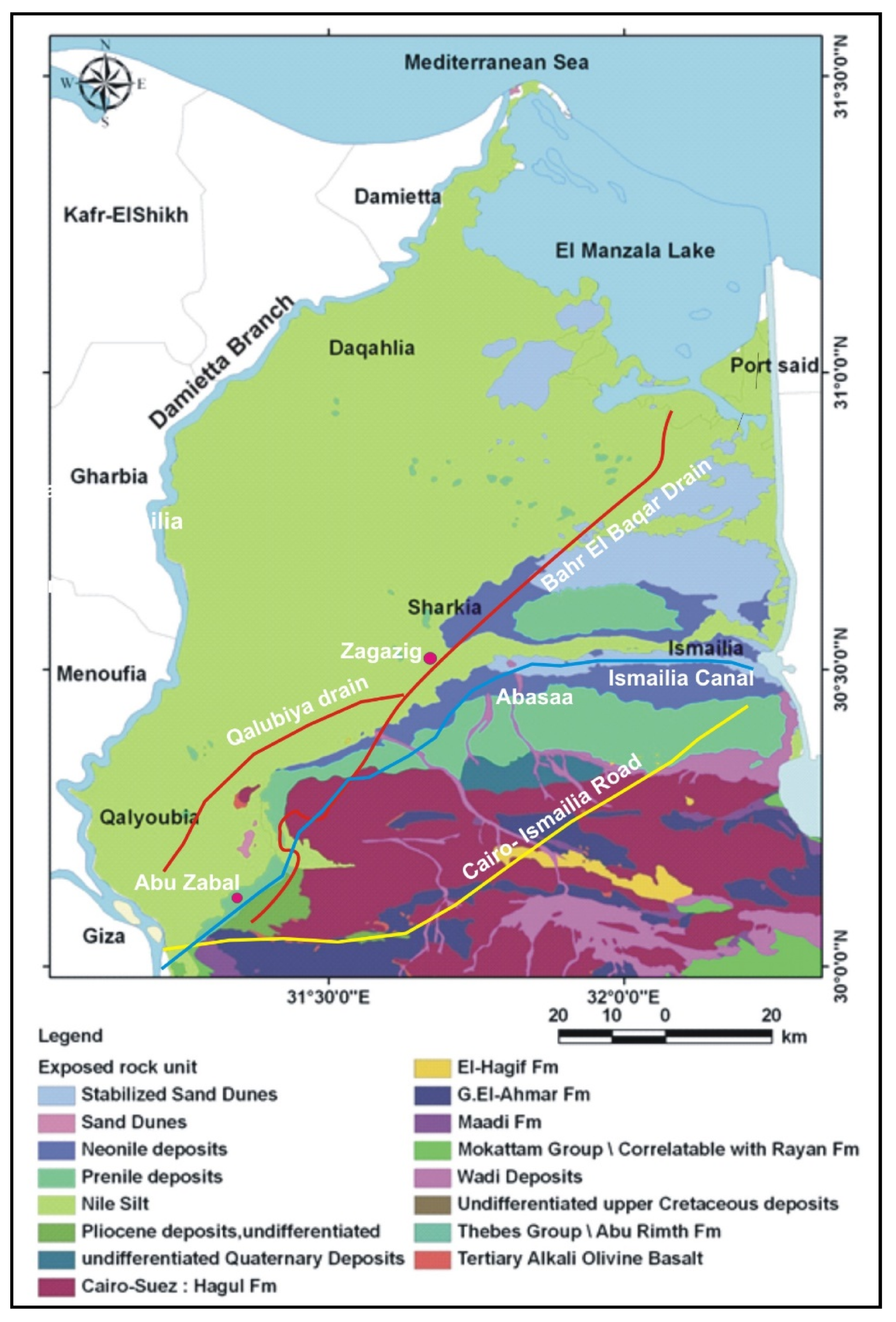
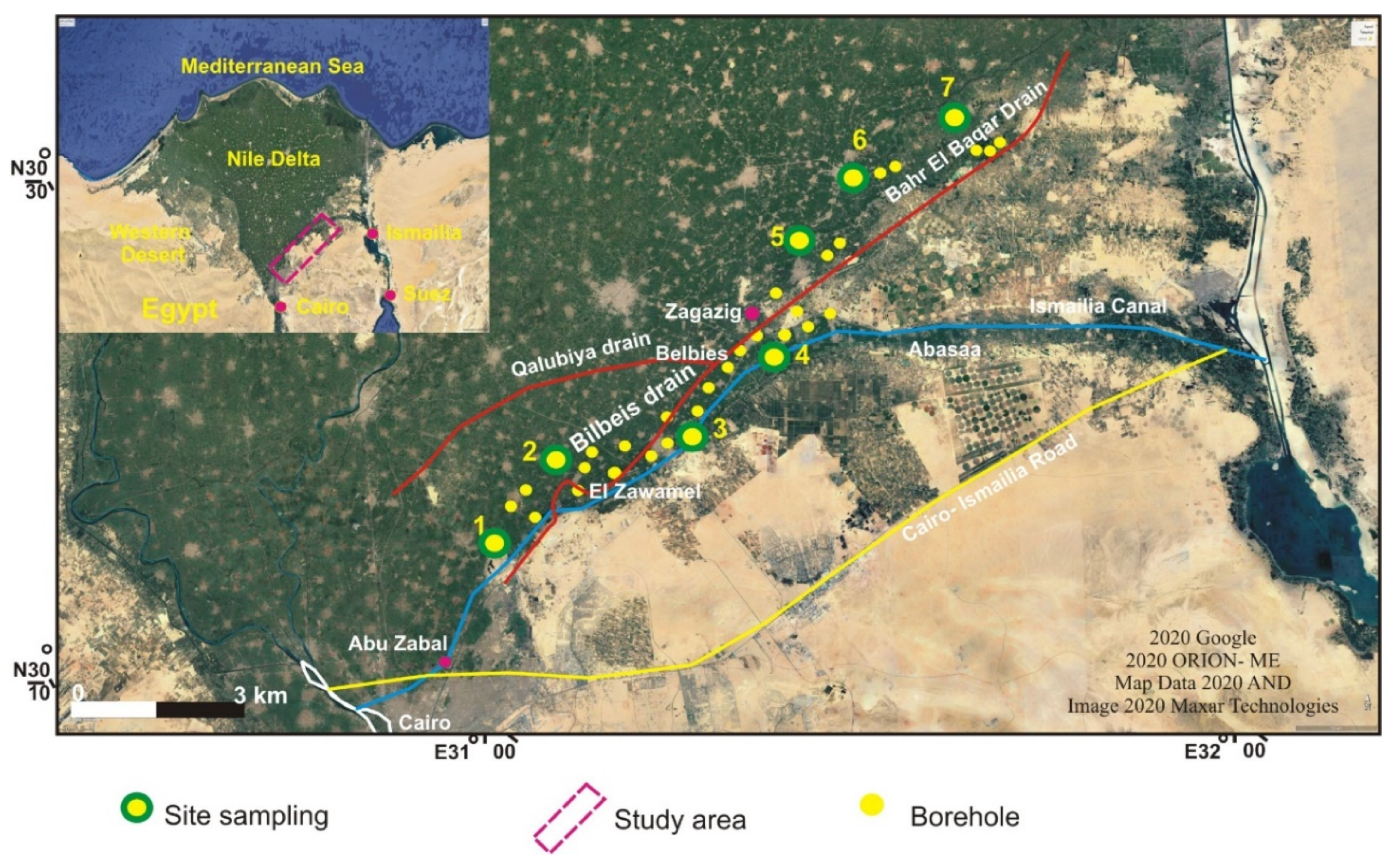
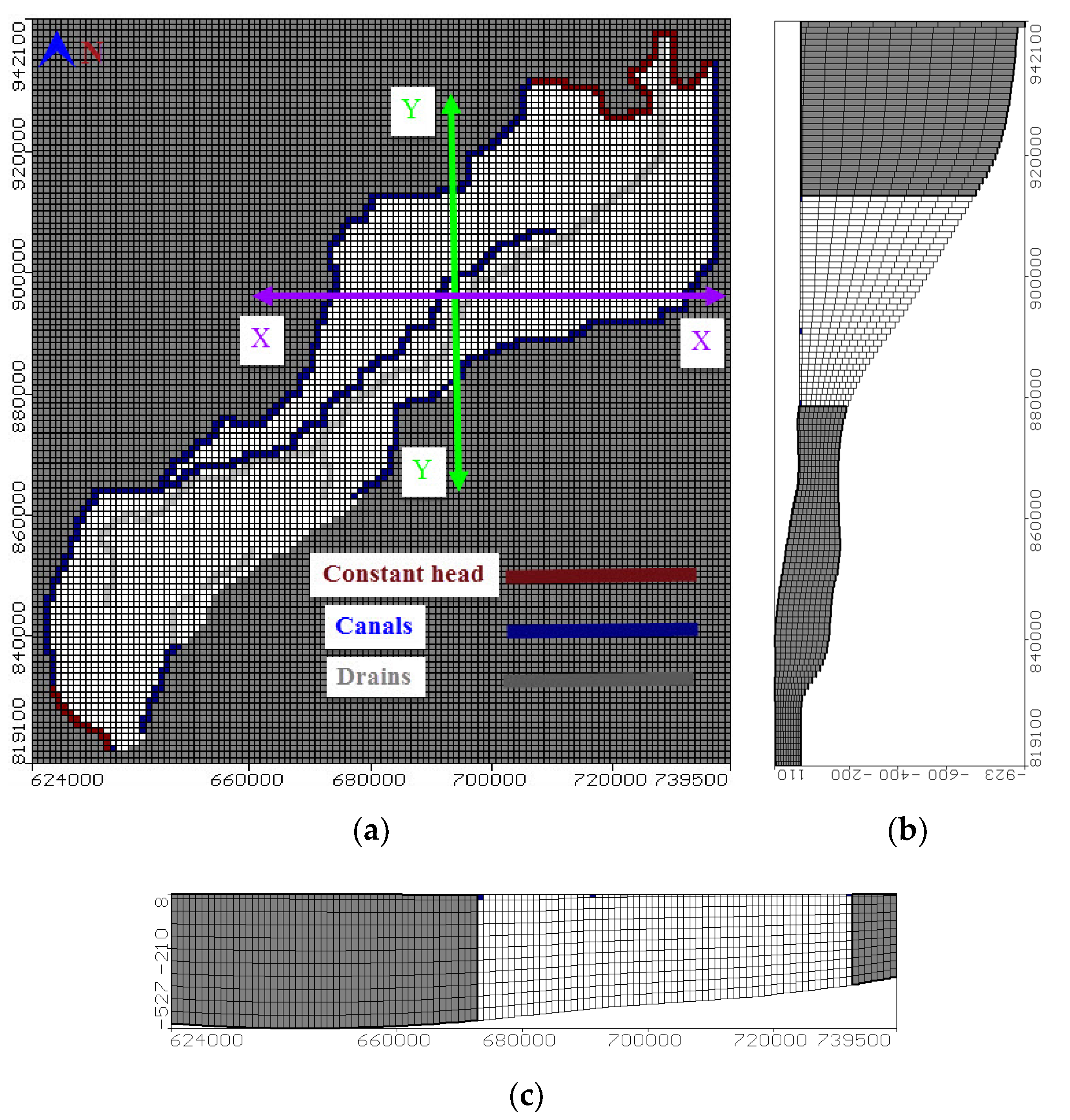
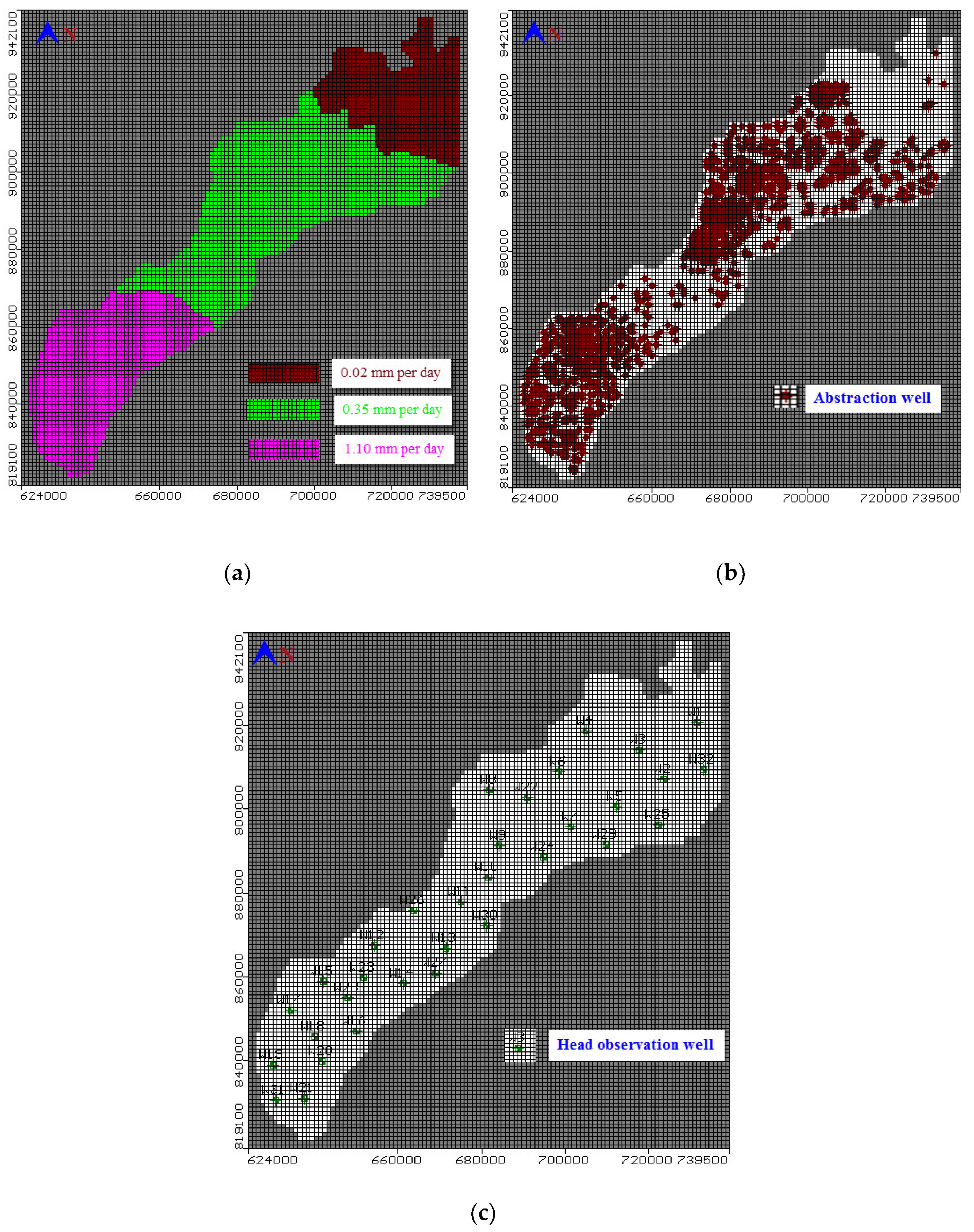
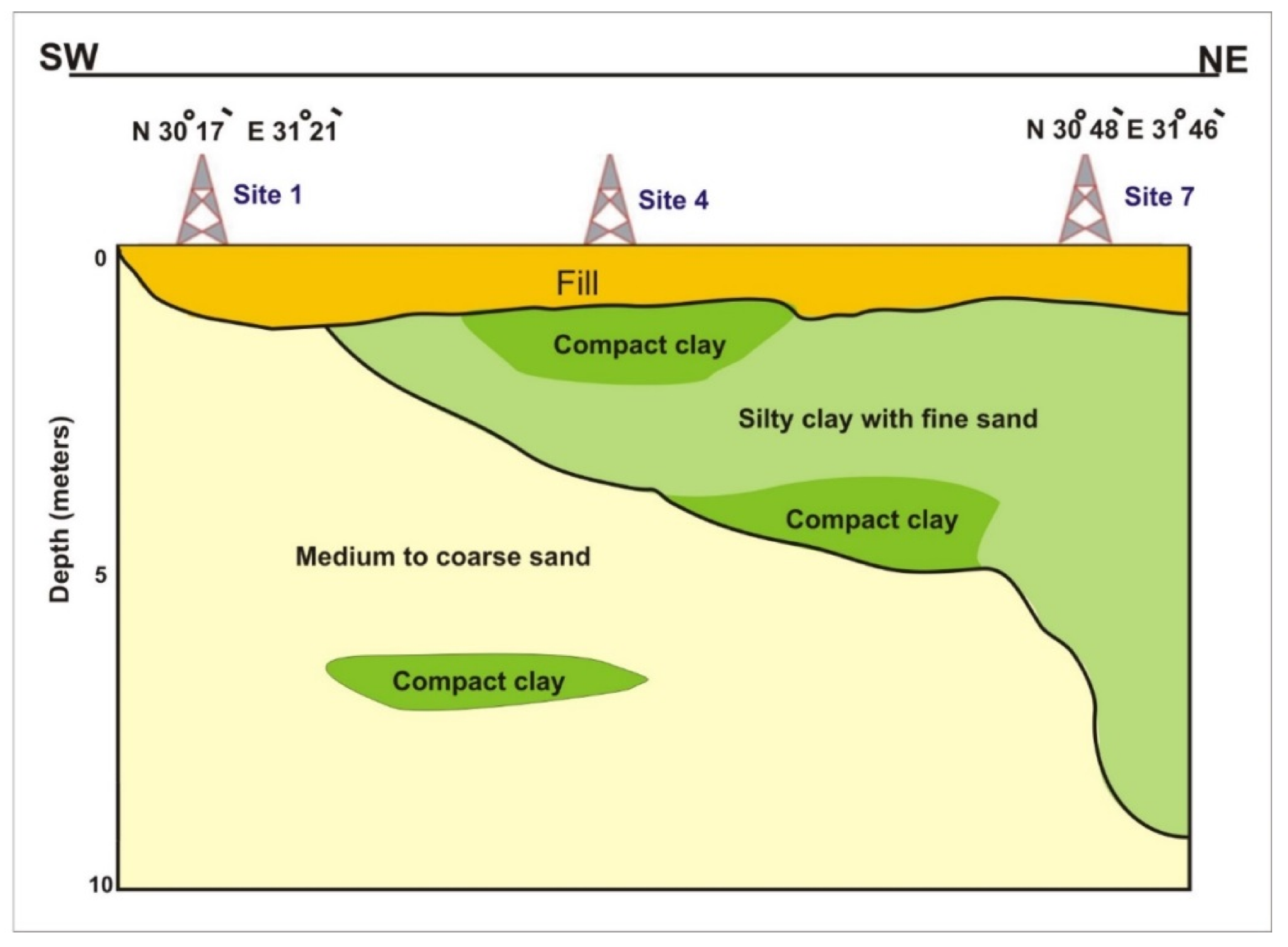

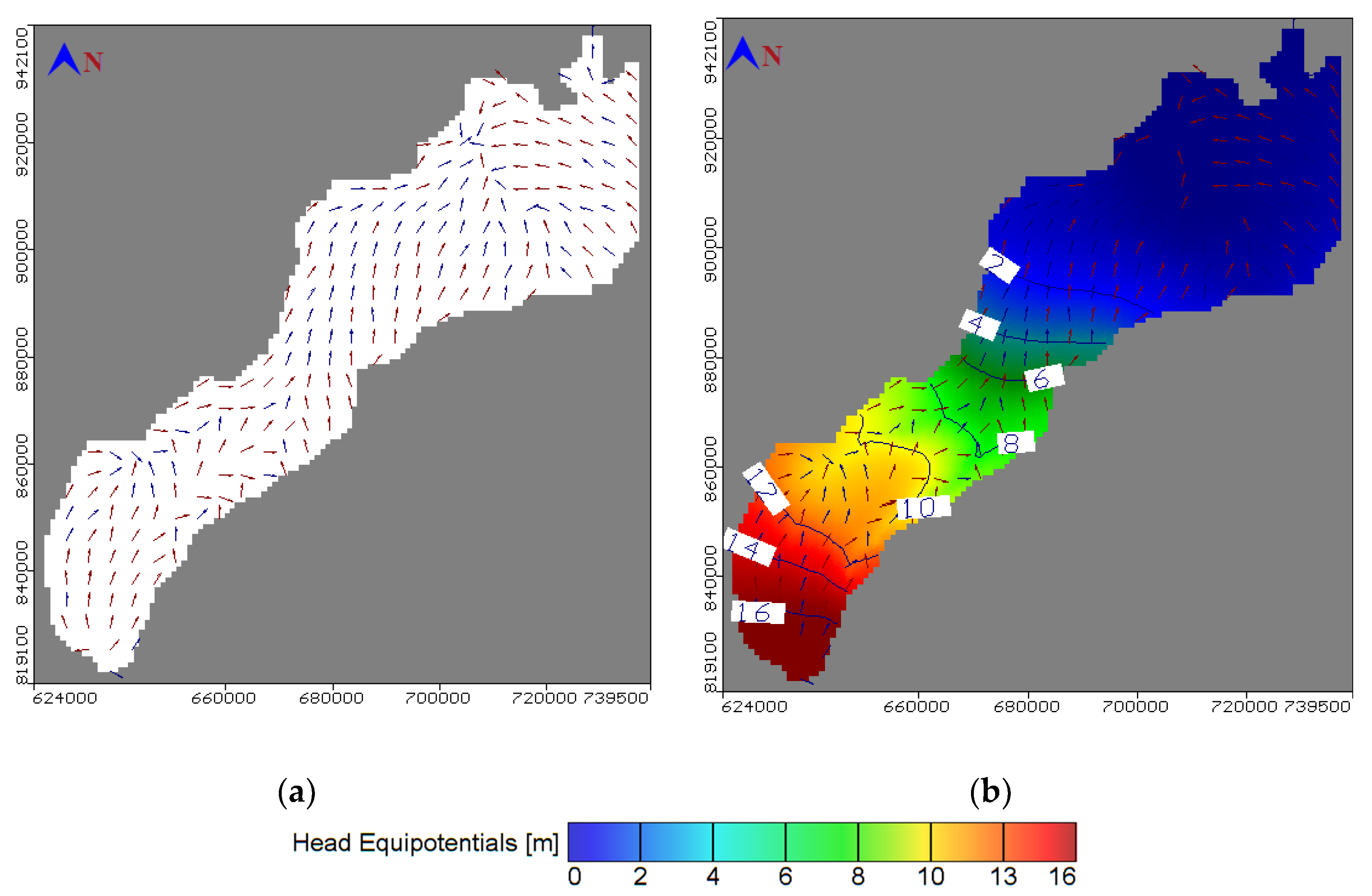
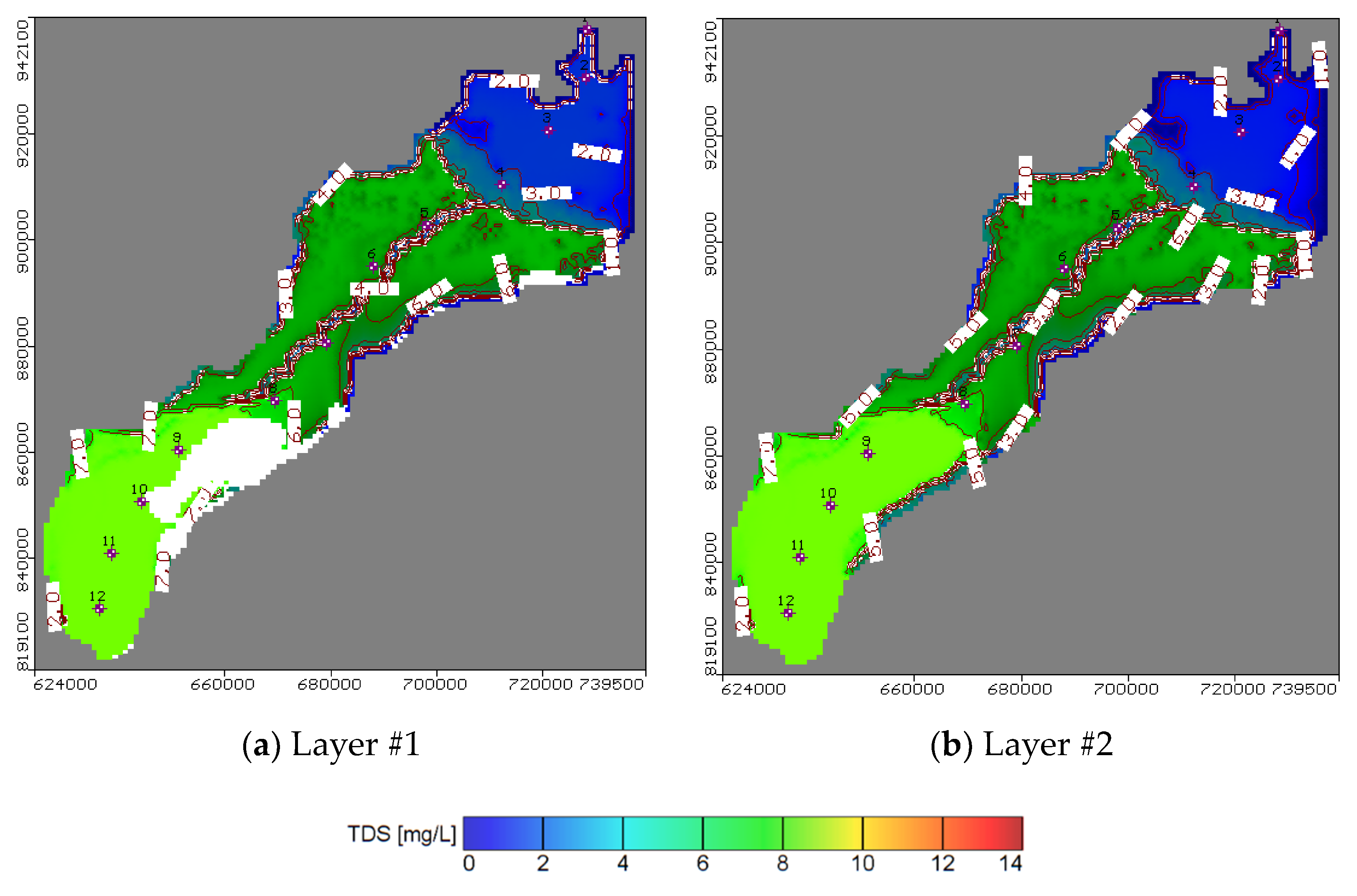
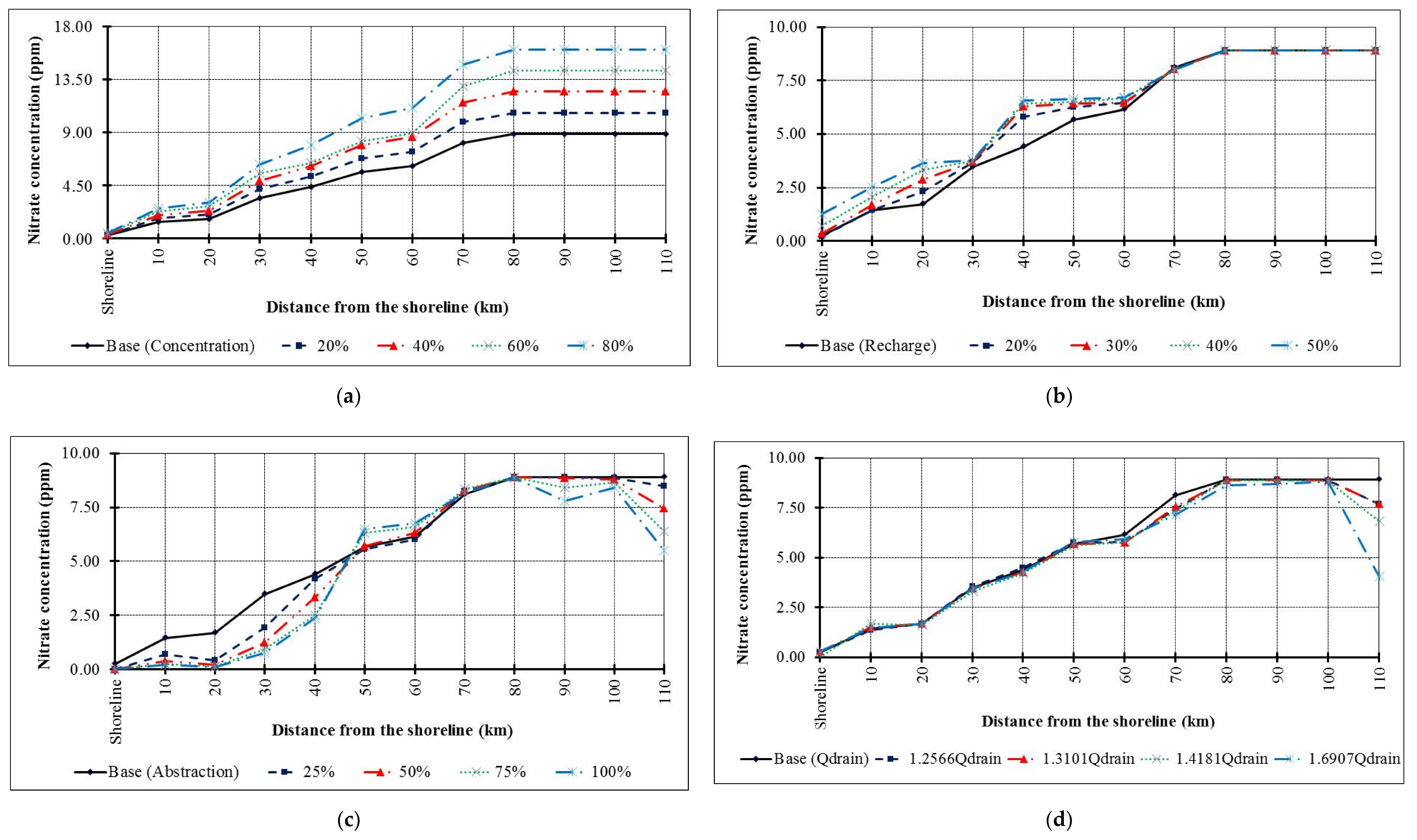

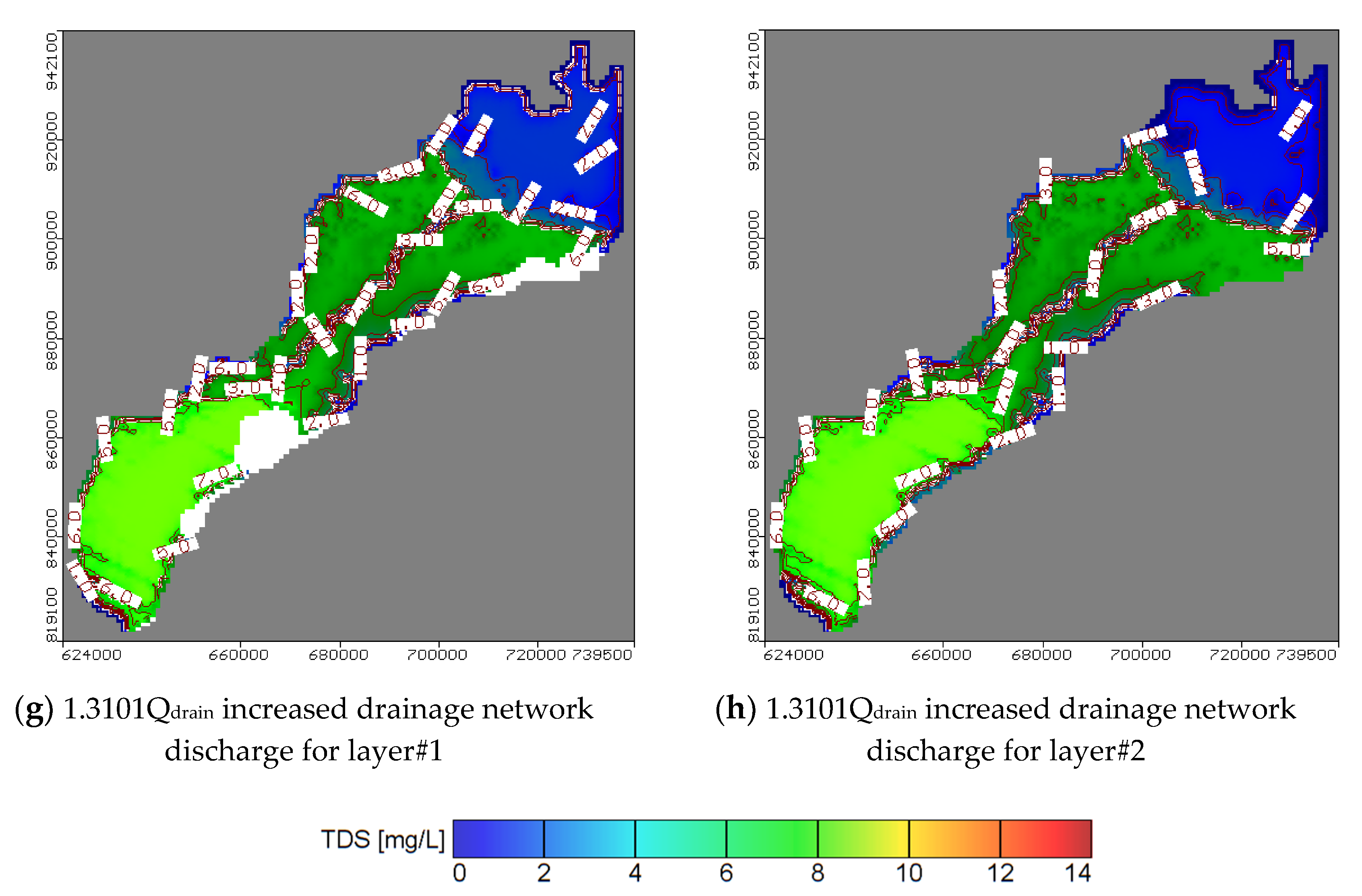
| Site | 1 | 2 and 3 | 4 and 5 | 6 and 7 | ||||
|---|---|---|---|---|---|---|---|---|
| Soil type | Sand | Silty clay | Sand | Silty clay | Sand | Silty clay | Silty clay | Silty clay |
| Porosity, n (%) | 55.88 | 62.42 | 68.75 | 78 | 55.88 | 70.96 | 40.43 | 52.63 |
| Bulk density, (g/cm3) | 1.74 | 1.78 | 1.78 | 1.71 | 1.74 | 1.82 | 1.84 | 1.75 |
| Dry density, (g/cm3) | 1.70 | 1.65 | 1.68 | 1.51 | 1.70 | 1.55 | 1.52 | 1.45 |
| Specific gravity | 2.65 | 2.68 | 2.73 | 2.7 | 2.65 | 2.65 | 2.73 | 2.71 |
| Wc, (%) | - | 14 | - | 14 | - | 23 | - | 27 |
| WL, (%) | - | 35 | - | 54 | - | 75 | - | 80 |
| WP, (%) | - | 22 | - | 28 | - | 30 | - | 33 |
| Hydraulic conductivity, k (m/day) | 0.136 | 0.124 | 0.140 | 0.002 | ||||
| SPT | 32 | 12 | 28 | 7 | 32 | 12 | 50 | 14 |
| UCS. (kg/cm2) | - | 1.1 | - | 1.22 | - | 1.45 | - | 1.52 |
| Friction angle, φ (°) | 30 | - | 25 | - | 25 | 12 | - | 7 |
| TDS. (mg/L) | 600 | 1200 | 2680 | 3600 | ||||
| Nitrates, (mg/L) for soil water extracts | 16 | 22 | 36 | 46 | ||||
| Nitrates, (mg/L) for groundwater | 10 | 7 | 5 | 3 | ||||
| Chloride, (mg/L) soil water extracts | 270 | 320 | 350 | 390 | ||||
| Sulphate, (mg/L) soil water extracts | 170 | 200 | 250 | 270 | ||||
Publisher’s Note: MDPI stays neutral with regard to jurisdictional claims in published maps and institutional affiliations. |
© 2020 by the authors. Licensee MDPI, Basel, Switzerland. This article is an open access article distributed under the terms and conditions of the Creative Commons Attribution (CC BY) license (http://creativecommons.org/licenses/by/4.0/).
Share and Cite
Abd-Elaty, I.; Pugliese, L.; Zelenakova, M.; Mesaros, P.; Shinawi, A.E. Simulation-Based Solutions Reducing Soil and Groundwater Contamination from Fertilizers in Arid and Semi-Arid Regions: Case Study the Eastern Nile Delta, Egypt. Int. J. Environ. Res. Public Health 2020, 17, 9373. https://doi.org/10.3390/ijerph17249373
Abd-Elaty I, Pugliese L, Zelenakova M, Mesaros P, Shinawi AE. Simulation-Based Solutions Reducing Soil and Groundwater Contamination from Fertilizers in Arid and Semi-Arid Regions: Case Study the Eastern Nile Delta, Egypt. International Journal of Environmental Research and Public Health. 2020; 17(24):9373. https://doi.org/10.3390/ijerph17249373
Chicago/Turabian StyleAbd-Elaty, Ismail, Lorenzo Pugliese, Martina Zelenakova, Peter Mesaros, and Abdelaziz El Shinawi. 2020. "Simulation-Based Solutions Reducing Soil and Groundwater Contamination from Fertilizers in Arid and Semi-Arid Regions: Case Study the Eastern Nile Delta, Egypt" International Journal of Environmental Research and Public Health 17, no. 24: 9373. https://doi.org/10.3390/ijerph17249373





